| This entry in the pubs menu is for an excellent pub in
Wolverhampton, a traditional pub, with a warm
welcome, excellent food and drink, and a wonderful
atmosphere. I will begin its history by
describing the growth and development of the area around Sun
Street.
From countryside to industrialisation
Before the opening of the canal in 1771, the area would
have consisted of open countryside, much of which would have
been cultivated. The coming of the canal allowed heavy
industries of all kinds to flourish, greatly changing the
area, in ways that would have been unimaginable to earlier
generations.
One of the first businesses to take advantage of this
part of the new canal was Joseph Norton's flour mill, known
as The Old steam Mill, which opened in the 1790s on Corn
Hill, named after the mill. Opposite the mill, where the
derelict sack mill now stands, was Bickley, Danks & Company's Wharf,
which opened sometime before 1818. Isaiah Danks lived in a
house beside the wharf, which is listed in the Staffordshire
General & Commercial Directory of 1818. The firm transported
goods daily to Stourport, Worcester, Gloucester, and
Bristol.
Another business that opened beside the new canal was
James Adams's Lime Works, off Wednesfield Road, which had
its own basin and wharf. Corn Hill was linked to Wednesfield
Road by New Mill Street, which had become Sun Street by
1851. It is marked on the 1843 Tithe map, and Joseph Bridgen's map of 1850, both of which can be seen below. |

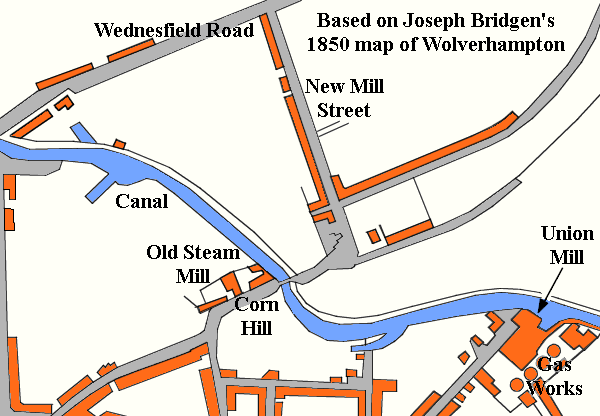
| Neither of the maps shows Bailey Street, or the Great
Western and its immediate surroundings. Bailey Street is
named after William Bailey, a successful chemical
manufacturer. Bailey & Son was founded in 1828 in North
Street, Wolverhampton, where it stayed until the 1840s when
the firm built the Horseley Fields Chemical Works beside the
canal. Bailey Street provided access to the works from New Mill
Street and Corn Hill. |

From Griffiths' Guide to the Iron Trade of
Great Britain, published in 1873.
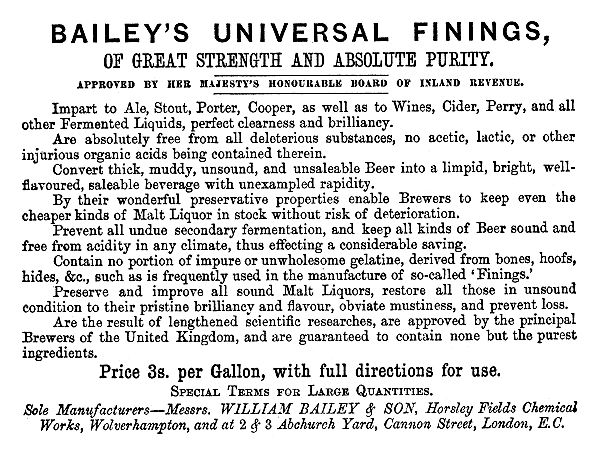
An advert from 1873.
| The building of the pub and its early
years In 1849 nineteen terraced houses were built
on the land between Sun Street and Bailey Street, the Great
Western occupying the largest of the houses, standing on the western
end of the site. The houses were built by the owner of the
land, Richard Robinson, from Rowington in Warwickshire. At this time the area would have been in a
state of upheaval with the coming of the Stour Valley
railway line, and the building of the embankment and bridge
that now dominate the neighbourhood. The railway crossed the
entrance to the Horseley Fields Chemical Works by an arched
viaduct. Before the railway could be built, the canal had to
diverted to make way for the High Level Station.
The railway opened in 1852, as did Mill Street Goods
Depot, which must have greatly increased the amount of
traffic in Sun Street. While this was happening, work had
started on the Low Level Station, known as The Joint Station
until April 1856. The station was the terminus of the
Shrewsbury & Birmingham Railway, the Oxford, Worcester, &
Wolverhampton Railway, and the Birmingham, Wolverhampton &
Dudley Railway, all constituent parts of the Great Western
Railway. The station opened in 1854, and was completed in the following year.
There was further disruption in the area in 1877 with the
building of the Midland Railway Good Depot, where the Royal
Mail building now stands. |
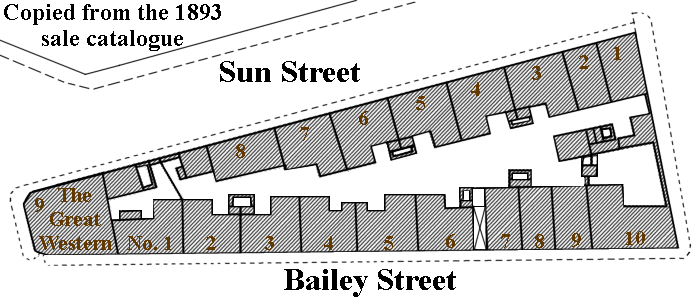
The 19 houses, as copied from a plan in the
1893 sales brochure.
| The end house soon became a beer house, a common form of
licensed premises in the nineteenth century. The licensee
was William Keay. Beer Houses
In the 18th century, gin replaced ale as the most popular
drink, after the Dutch brought it here in the late 1680s. It
was cheaper, more alcoholic, and readily available.
Drunkenness became commonplace, and on several occasions the
government introduced legislation in an attempt to reduce
the problem. It was in this atmosphere that the modem public
house was born.
The 1830 Beer House Act
Beer was considered to be a harmless, nutritious
alternative to gin, the consumption of which should be
actively encouraged. This idea led to the Passing of the
1830 Beer House Act that introduced new and radical changes
to the law. It allowed any householder and tax payer to
obtain a license to sell beer on their premises, in exchange
for a 2 guinea licence fee. Licensees were not allowed to
sell spirits or fortified wines. Anyone doing so would be
closed down, and heavily fined.
The new legislation led to a rapid rise in the number of
public houses, and the introduction of a new class of
licensed premises, the beer house. Beer houses were family
homes, in which beer was usually sold in the front room, and
dispensed from a jug, or directly from the barrel. Often the
room was simply furnished with bare floorboards, wooden
benches, and trestle tables. Some of the
early beer houses carried names, just like pubs. The Great
Western was initially known as 'The Board', until
the coming of the Great Western Railway.
There were many beer houses in Wolverhampton. William
White's History, Gazetteer, and Directory of Staffordshire
published in 1851 states that there were around 170 fully
licensed premises in Wolverhampton, and around 150 beer
houses.
Beer houses flourished until the introduction of the Wine
and Beer House Act of 1869, which prevented the opening of
new beer houses, and tightened local magistrates' control of
the industry. By the early years of the 20th century they
had all gone. Many of them became fully licensed, as did The
Great Western, and still survive as pubs today. |
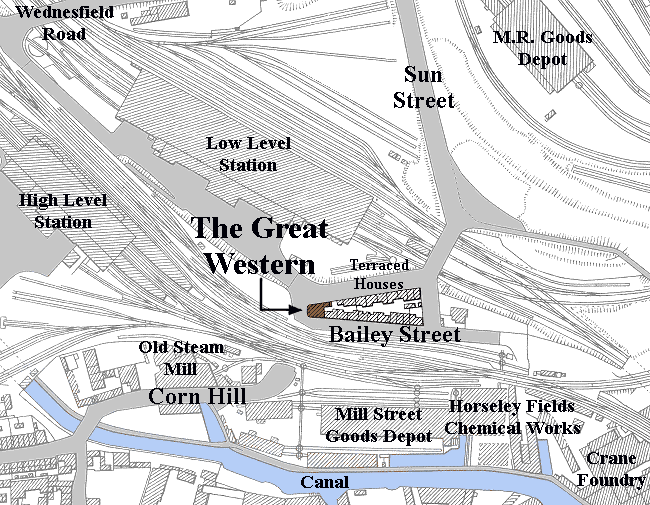
The Great Western and its surroundings in
1901.
|
In 1893, twelve years after Richard
Robinson's death, his estate was sold at auction and
acquired by William Butler & Company Limited based at the
nearby Springfield Brewery. At the time, Butlers were an
expanding company, acquiring public houses, and extending
the buildings at Springfield Brewery, which had been open
for nineteen years.
The company continued to expand,
becoming one of the four largest brewers in the West
Midlands by 1950. The other three were Ansell's, Mitchells
and Butlers, and Wolverhampton and Dudley Breweries.
In 1960 William Butler & Company
Limited was taken over by Mitchells & Butlers of Cape Hill.
A year later Mitchells & Butlers merged with Bass, Ratcliff
& Gretton to form Bass, Mitchells & Butlers Limited.
The Great Western must have greatly benefited from the
nearby businesses which would have brought many customers
into the pub, both at lunchtime and in the evening. Railway
workers and passengers from the two railway stations must
have frequented the bar, as would workers from Mill Street
Goods Depot, the Midland Railway Goods Depot, the Old Steam
Mill, and Joshua Bigwood & Son Limited, situated on the
opposite side of Wednesfield Road. Customers must also have
come from the numerous houses in the Horseley Fields area,
and at Heath Town. |
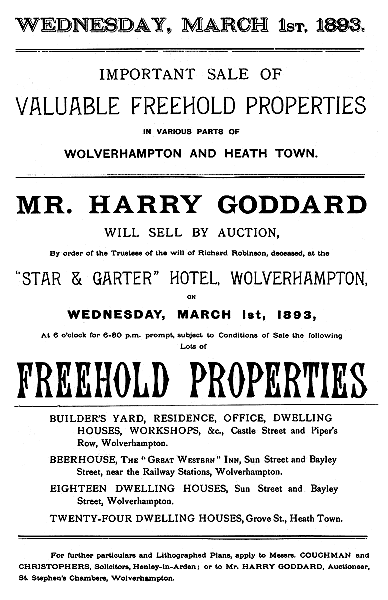
Details of the 1893 sale. |

The Great Western in 2012.
|
In 1987 The Great Western was sold to
Holdens Brewery Limited, its present owner, and two years
later the single storey extension was built. On 31st March,
1992, the pub was Grade II Listed. The description in the
listing is as follows:
|
Public House.
1850s. Brick with blue brick patterning
and ashlar dressings, some plaster;
hipped double-span slate roof with brick
stacks. 2 storeys; 2-window range with
canted angles. Cornice over plastered
ground floor; painted 1st floor and top
brick cornice. 4 ground-floor windows,
including 2 to angles, with
6-over-one-pane horned sashes; 2 windows
to 1st floor with 12-pane sashes;
central entrance has overlight with
margin lights and panelled door. Right
return similar, with exposed brickwork;
narrow recessed blue brick courses to
ground floor with cogged frieze over;
diapering to 1st floor; sashed windows
and entrance with small-paned overlight
and panelled door; lateral stack and
right gable-end stack; left return
similar, but painted. 1989 single-storey
addition to rear.
Interior: retains
central bar, moulded cornicing and
ceiling roses. An interesting survival
of a public house in a complete group of
railway buildings. |
|
In 1995 the conservatory, with its bar
opened as the Armstrong Room, named after brothers Joseph
and George Armstrong who in turn ran the Stafford Road
railway works, and designed the locomotives that were built
there.
The Great Western has received many
awards including CAMRA National Pub of the Year in 1991,
Wolverhampton CAMRA City Pub of the Year in 2003, 2004, and
2011, and is listed in the 2014 Good Pub Guide as follows:

The pub also featured in a Hairy Bikers
TV programme in September 2011, and in the Sky TV
promotional film for the 2012 World Darts Championships.
Much of the local industry and
the old houses are now gone. For several years, Corn Hill
was permanently closed due to the dreadful arson attack on the Old Steam Mill,
leaving the pub somewhat isolated. The road has now
reopened, and the pub continues to be
successful. It has a wonderful atmosphere, excellent food,
one of the best pints in Wolverhampton, and superb staff. A
pub is only as good as its staff, and the people who work in
the Great Western always offer the warmest of welcomes, and
provide the very best service to all customers. Hopefully it
will continue in this way for many years to come. |

The view from under the railway bridge.
| Owners: Richard Robinson
from Rowington in Warwickshire
William Butler & Company
Limited purchased the pub in 1893. In 1960
William Butler & Company Limited was taken over
by Mitchells & Butlers of Cape Hill, and in 1961
Mitchells & Butlers merged with Bass, Ratcliff &
Gretton to form Bass, Mitchells & Butlers Ltd.
Holdens Brewery Limited
purchased the pub in 1987.
|
|
| |
Licensees:
William Keay
James Yearsley
Mrs. Sarah Yearsley
William Turner
Thomas Appleton
George Morris
George Morris Junior
Walter Pitcairn Solloway
Mrs. Nettie Solloway
Mrs. Lydia Mary Solloway
Henry Dennis Brookes
Alan Davies
Francis Cairns
John Anthony Hennessy
Violet Hennessy
Cyril Henry Morgans
John Raymond Ward
Kerry Morgan
Leonard William Fenton
John Henry Nunn
Keith Walker
Kevin Michael Gould
Jamie Roderick Atkins |
1849 to 1856
1856 to 1872
1872 to 1873
1873 to 1881
1881 to 1888
1888 to 1896
1896 to 1912
1912 to 1928
1928 to 1932
1932 to 1951
1951 to 1959
1959 to 1964
1964 to 1966
1966 to 1967
1967 to 1968
1968 to 1970
1970 to 1972
1972 to 1974
1974 to 1981
1981 to 1987
1987 to 2001
2001 to 2008
2008 to 2021
|
|

The Great Western in the late evening.

The view from the single storey extension
looking towards the bar.

Another view from the extension.

Two of the most excellent members of staff.

Two other, equally excellent members of staff.

Part of the conservatory, with its bar and
wood burning stove.

A corner of the bar showing the interesting
decor, and one of the three fireplaces.

The small side-room, with a lot of character.

Regulars enjoying a pint and a chat in a
corner of the bar.
| In May 2017 the Great Western and the Swan at
Compton, jointly won CAMRA's Mild Pub of the Year.
Jamie Atkins has decided to step down as landlord at the
Great Western. He finished on the 1st March, 2021. He
has returned to his own pub, the Old Gate Inn in
Heathton. |
 |
Return to
the
pubs menu |
|